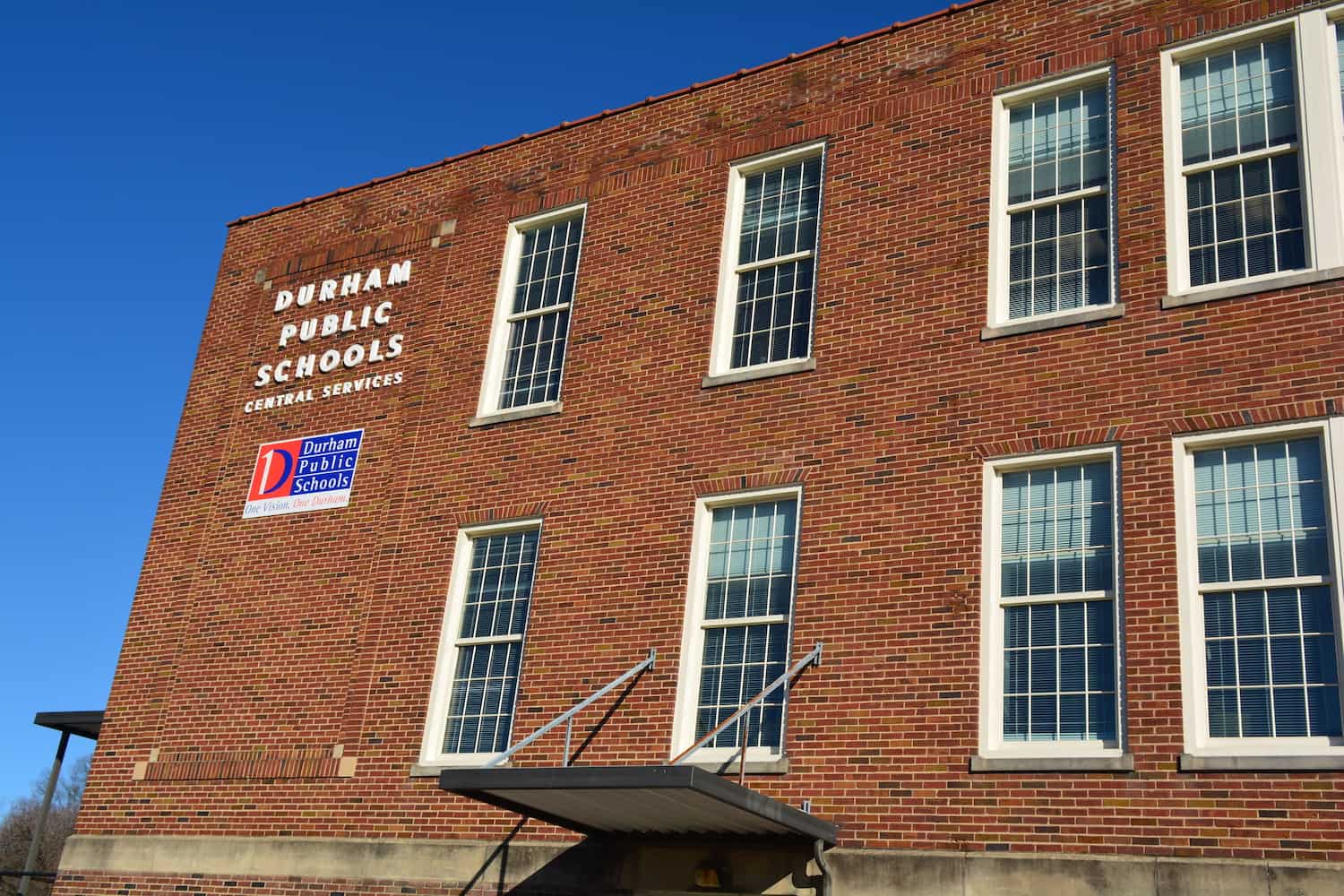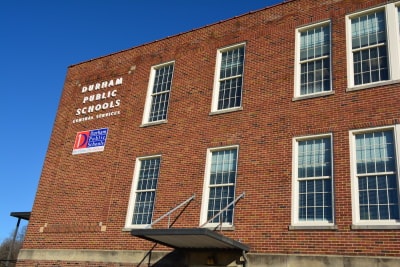Editor’s note: This is the fourth in a six-part series on the Durham Public Schools that originally appeared at the Bull City Rising Blog. The articles are reprinted here with authors’ permission.
As we saw yesterday, Durham Public Schools (DPS) spends more per pupil than any of the other large urban districts in the state. Out of all 115 NC school districts, only Asheville, Chapel-Hill/Carrboro, and Dare County contribute more local dollars (per pupil) to public education.
Yet DPS’ leadership in spending isn’t matched by high or even acceptable performance outcomes, relative to large districts, peer districts, or low-SES/high-need districts.
This paradox presents the linchpin of the troubling data we’re trying to understand in looking at DPS:
- With such a striking lag in performance, and such a glaring difference in white vs. minority performance, how can DPS be meeting its requirement to provide an equal educational opportunity for all?
- And, if Durham is outspending its peers for poor results, where are we “spending in the wrong ways,” or where could taxpayer dollars go to create better outcomes?
In today’s installment of the series, we’re going to drill in further to the spending question to try to explain the significant gap in spending between DPS and its most similar North Carolina peer districts — Cabarrus, Johnston, and Gaston.
While 77% of Durham’s spending surplus versus those three systems does go to what the NC DPI calls “instructional” services, comparatively little — only about one in every four dollars in this category — goes to regular classroom instruction.
Nearly the same one in four dollars goes towards spending on in-school resources like principals, non-instructional school support staff, and other functions. And, the remainder goes to exceptional children and alternative instructional programs — two areas where DPS spends much more than its peers, despite having almost identically-sized EC student populations.
And as to administrative spending? The hard truth is, if DPS cut its spending in these central office functions to the average level of its three peers, it could fully fund universal Pre-K — or alternatively, could recapture every dollar “lost” to charter schools.
Remember that rabbit hole? It gets murkier, and a bit more disorienting, the deeper we get.
Classroom and instructional spending
Given DPS’ significant local funding advantage, one would think the district’s opportunity for additional spending would be a boon for classroom instruction.
Comparing the four districts in their spending on regular instructional services — that is, excluding exceptional children and alternative programs students — DPS spent $141.4 million in 2014-2015.
Johnston was close, at $133.5 million; Gaston and Cabarrus spent $112.1 million and $111.6 million, respectively.
As you’d expect, on a per-pupil basis, DPS spent $4,252 per student on regular classroom instruction, to Johnston’s $3,946, Gaston’s $3,583, and $3,710.
But compare those per-pupil figures to these:
- $2,415 — the average per-pupil advantage DPS has over the three comparison districts in total spending after adjusting for charter school spending
- $2,295 — the per-pupil advantage DPS has over its three peer districts just in local funding.
Given that mainstream classroom education is the overwhelming point of DPS’ mission, I would have assumed that the bulk of DPS’ extra spending and resources would find its way to this mission.
But, it doesn’t. The $506 per pupil advantage in DPS spending in this category reflects only 21% of Durham’s overall extra school spending compared to Cabarrus, Gaston and Johnston.
Or viewed another way, irrespective of local funding vs. DPS’ other funding sources: DPS spends significantly less of its budget on regular instructional services than these three peer districts do:
- Durham: 36.5% of budget supports Regular Instructional Services
- Cabarrus: 42.8%
- Gaston: 41.8%
- Johnston: 43.5%
All told, if DPS’ funding for regular classroom instructional services matched its peer districts, this would translate to nearly $24 million in additional annual spending on mainstream instructional services.
If we’re spending $2,415 more per pupil — and 79% of that money is going somewhere other than regular classroom instruction — just where the heck is it going to?
In-school support services and alternative instructional programs
For every $1 of extra spending we see DPS using towards regular classroom instruction, it spends nearly that same $1 on additional in-school support resources — and nearly two dollars on programs for special populations, such as exceptional children classes and AIG (gifted) programs.
Let’s look first at those support services: school leadership services (principals/assistant principals and clerical staff), co-curricular services, and support functions like guidance, school health and security services, school IT, and educational media services.
DPS outspends its peers by $8.6 million on school support functions; $1.7 million on student accounting services; and, a whopping $6.0 million on school leadership, bolstering its state-allocated 33.1 assistant principal headcount with another 47.0 FTEs on the district’s dime — two issues we’ll look at more closely tomorrow.
Ironically, although it is widely acknowledged by DPS board members that children from economically disadvantaged households benefit from support services including early childhood education and school-based health services, these are two of the very few categories in which DPS actually spends less than its peer districts.
Compared to Gaston (which is closest to DPS in the number of economically disadvantaged students that it serves out of all three peers), Gaston spends $5.3 million annually on pre-K, compared to DPS’ $1.9 million, and $3.7 million compared to DPS’ $1.4 million on health services.
Combined, Gaston invests $6.7 million more annually in Pre-K and health support, despite having an operating budget $119 million below that of DPS. Perhaps unsurprisingly, when it comes to K-12 remedial services, the tables are turned, with DPS spending about $7 million more annually than Gaston.
Besides support services, special classroom environments appear to consume a disproportionate share of the extra spending.
By contrast with its three peers, DPS spends more as a percentage of its budget than any of its peers on so-called “special population instructional services” — a grouping that includes both so-called AIG (talented/gifted) programs as well as students with special learning needs — and alternative programs.
DPS last year spent $32.7 million more than its three peers in this area, or nearly $916 per pupil. That dwarfs the nearly $506 per pupil in extra regular classroom instruction spending. This included:
- AIG programs: $155 per pupil ($102 per pupil more than peer districts)
- Students with disabilities: $972.37 per pupil ($286 per pupil more than peer districts)
- Remedial/supplemental K-12 services: $521.21 per pupil ($215 more than peers)
- Limited English Proficiency students: $199.95 per pupil ($128 more than peers)
In total, DPS spends $2,232 on EC/alternative programs per pupil (excluding AIG) — versus $4,252 per pupil for regular instructional services. This compares to an average of $1,417 per pupil for students in Cabarrus, Gaston and Johnston County.
A different mix of students than these peer districts might explain the matter (e.g., if Durham had a higher rate of exceptional children in its population.)
But, at least against the top-line EC headcount, it doesn’t: 13.6% of DPS’ 2014-15 population were EC students, vs. 12.1% in Cabarrus, 14.1% in Gaston, and 15.9% in Johnston.
Of course, these populations include many that are high-risk and face many disadvantages in life; and, it seems almost Dickensian to consider scrutinizing that spending. Yet, given DPS’ lagging performance in academic achievement in these students’ measures, too, we must ask again: why are outcomes seeming to lag the spending?
Central office administrative positions
Ultimately, just over three quarters of Durham’s extra spending goes to instructional categories — albeit that’s a metric that includes school support functions and non-regular classroom needs absorbing the great bulk of any differential excess spending.
While administrative expenses in DPS and its peer systems are, as one would expect, smaller than instructional costs, they represent an important area for scrutiny since they only touch student learning indirectly at best.
And after comparing data between DPS and peer systems, we’re curious why these expenses don’t get as much scrutiny as, say, spending on charter schools.
DPS leaders and elected officials routinely bemoan the revenue lost to charter schools. And indeed, DPS’ 2014-15 budget figures show $18 million in transfers to other government units — largely for charters, and representing $15.4 million more than its three peer districts.
Yet DPS in the same year spent $21.9 million more on central office expenses than its peers.
Put another way, if DPS’ central administrative spending matched its peers, it could fully cover the entire impact of charter schools with several million dollars to spare. (Or, for that matter, the full cost of universal Pre-K for 4-year-olds.)
Drilling into specific categories of central administration, compared to its three peer counties by size, DPS spends more in just about every area of overhead:
- $1.5 million more on financial services
- $1.8 million more on human resources
- $1.7 million more on leadership services
- $500,000 more on public relations
So where does the extra spending go?
For one thing, compared to these peer systems, Durham Public Schools at least appears to have a significantly larger administrative or “middle management” staffing layer in its budget.
DPS’ budget includes 69 positions flagged as directors and supervisors for its 33,300 student population, with an average salary of $77,700 for these positions, for nearly $5.3 million.
By comparison, Gaston County’s 31,100 student district has a similar average salary for central administrative directors and supervisors ($78,000), but notes only 13 employees in these positions. This translates to a nearly $4 million difference.
This higher spending level stands out more when compared to Cumberland County (Fayetteville), a district with nearly 20,000 more students than DPS, yet which spends over $3.5 million less on directors/supervisors than DPS.
Another area of difference: spending on senior leadership positions.
In addition to the six-figure maximum allowable state salaries for their positions, the superintendent receives a local supplement of $86,000, two assistant superintendents receive a local supplement of $32,541, the CFO receives a local supplement of $28,768, and five associate superintendents receive a local supplement of $25,006.
In total, DPS spends over $1.1 million in salary alone for a superintendent and seven assistant superintendents. Meanwhile, Cumberland’s significantly larger district has the same number of senior leaders — and a total budget of $740,000.
There are other curiosities that stand out in DPS’ administrative budget, too.
One unique area of difference? Warehousing. The NC DPI charter of accounts defines the warehouse services as “costs of activities concerned with the receiving, storing, and distributing of supplies, furniture, equipment, materials, and mail.“
DPS is the only district of its size in the state listing expenses for warehouse services, at a cost of over $1 million per year. From what we’ve heard from those listening to the DPS budget process, this seems unique among the peer districts; we surmise the other districts skip this step, ordering supplies and materials directly from vendors, and store supplies and equipment on site.
All together, though, the additional headcount of Durham Public Schools has to be one of the areas for close scrutiny during the budget process.
Compared to the three districts we’ve looked at today and yesterday, DPS has an average of 983 more full-time equivalent (FTE) positions.
Yet it has only 419 more teachers, on average, than these three peers. The remainder of extra staffing is all in non-instructional or support roles.
Even if our administrative staffing was merely equivalent to the other three peer districts, and the overall budget was unchanged — that would translate to 564 more teachers, enough to reduce DPS’ students-per-teacher ratio from nearly 14:1 to about 11:1.
What difference in students’ lives could nearly 600 more teachers make?
But that’s just one possible path we could imagine DPS leadership taking.
Tomorrow, we’ll look at the decisions made in the past on staffing, vis a vis teacher and principal headcounts and allocations.
Source Data:



